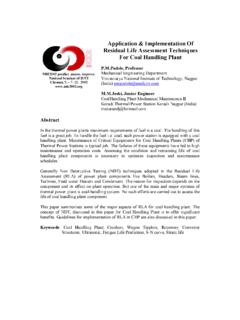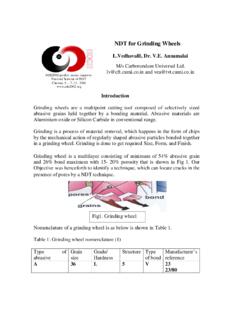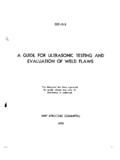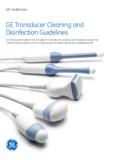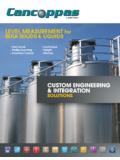Transcription of ON THE CALIBRATION OF ULTRASONIC FLAW …
1 NDE2002 predict. assure. improve. National Seminar of ISNT Chennai, 5. 7. 12. 2002 ON THE CALIBRATION OF ULTRASONIC FLAW DETECTOR Yudhisther Kumar, Ashok Kumar and Reeta Gupta Ultrasonics Section, National Physical Laboratory, New Delhi - 110 012 ABSTRACT For the assessment performance of the ULTRASONIC flaw detector (UFD) equipment, various standard documents are referred to such as ASTM (E-317), British Standard (BS-4331), Bureau of Indian Standard (IS-12666), and more. The methods of CALIBRATION are spelt in different tone in these documents while broadly serving the same purpose.
2 In the present paper a comparison for the CALIBRATION procedure for evaluation the performance of UFD for different parameters are given. NPL as a National Measuring Institute of India is providing the facility for the CALIBRATION of ULTRASONIC flaw detectors according to the different procedures on request from the users. Study has been made to analyse the different procedures and the most suitable CALIBRATION procedure is suggested in the present work, while keeping the essentials of recommended procedure in the standard.
3 INTRODUCTION International compatibility requires that instruments made at different factories are first inspected for quality control, depending upon its ultimate application and end use. Every instrument however must comply with two very important criteria. It must be easy to use and that it must give reproducible results within certain limits of accuracy. The former is taken care of by sensible design. The later is difficult to achieve and can be by a hierarchy of CALIBRATION steps traceable to national and international measurement standards through an unbroken chain.
4 International Standard (BIPM) - National Standard (NPL) - Transfer Standard - Secondary Standard (States) -Working Standards (inspectors) - Commercial Measures. The chain of traceability, extending from the national standard down to the end user should be applied to all users of the instruments. Hence the instruments must be calibrated and verified by an accredited and nationally approved laboratory regularly so that measurements made in any factory are traceable to the standard and hence do not differ with measurement made elsewhere.
5 We will discuss the CALIBRATION procedure of the ULTRASONIC Flaw Detector, which is commonly used in the industries for nondestructive testing and evaluation, in the following section of the paper. Under the national acceredation board of laboratories (NABL), NPL is coordinating the program of accreditation of CALIBRATION laboratories. This program provides technical support and critical measurement control for Quality System Certification under ISO-9000/ IS-17025.
6 ULTRASONIC Group at NPL is maintaining and updating the primary standards, does CALIBRATION , testing and evaluation of equipment used in ULTRASONIC NDT. In the present paper procedures given in standards1-8 (British Standards BS 4331, Indian Standards IS-12666, ASTM-E- 317 and E-1324) are studied and compared. The standards are referred for testing and CALIBRATION of UFD equipment. CALIBRATION OF ULTRASONIC FLAW DETECTION SYSTEM. CALIBRATION involves evaluation of some parameters of the equipment and comparing these with the standard available in the standards maintaining institute at national level.
7 The ULTRASONIC Flaw detection system comprises of an ULTRASONIC Pulse echo system (UFD), transducer, interconnecting cables and couplant. ULTRASONIC response from appropriate test block 2,6 is obtained and presented in the numerical for the test data are used to characterise the related system parameters in accordance with users requirement. Various parameters generally measured or calibrated are as follows. 1. Linearity of time base or horizontal linearity 2. Linearity of equipment gain or vertical linearity 3.
8 Sensitivity and Signal to noise ratio 4. Penetrating Power 5. Resolving Power 6. Operating frequency 7. Transmitter pulse Characteristics 8. Gates, range of gate width & delay 9. Variation in power supply For measurement of some of these parameters, different procedures are given in different standard procedures written in the standards. British Standards has elaborately explained and written the procedures in three different parts. American Society of Testing Materials (ASTM) standard has written different standards for electronic characteristics and pulse echo test system without electronic measurement of instrument.
9 Indian standard specify only ULTRASONIC flaw detection system and not the electronic characteristics of excitation pulse of UFD. Whereas the CALIBRATION or performance of the equipment depends on the characteristics of excitation pulse of UFD, receiving signal characteristics, amplifiers, transducer and cable characteristics and the reference standards blocks used for measuring the characteristics. The table 1. shows parameters and procedures for their measurement in brief.
10 TABLE Parameters Procedure of measurement Horizontal linearity Indian Standards : Using IIW V1 or A2 block time base is adjusted for multiple echo pattern display. Range is set or calibrated for 100 or 500mm for at least two of bottom echoes, first and last. Then intermediate echoes should line up with appropriate positions. Intervals between leading edges of successive bottom echoes are measured and their deviation (a max) with respect to graticule is recorded. If b is the full scale of time base linearity is given as (a max / )100% British Standards : Using IIW V1 / A2 block range is set separately for L-wave and S-wave probes.



